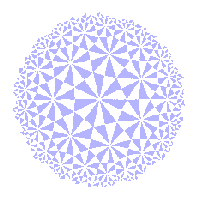
 |
The Klein View of Geometry |
|
In the inversive geometry pages,
we introduced inversive geometry. This is defined on the set C+ = Cu{∞}. We defined i-lines and inversion in i-lines. Here, we determine the group I(2) generated by such inversions. This is the inversive group. Its elements are inversive transformations.
We know that each inversion preseves the size of angles, but reverses their sense.
An i-line is either a circle or an extended line (a euclidean line plus the point ∞). In particular, I(2) contains extended versions of
These extended versions form a group S(2) isomorphic to S(2). This is also a subgroup of I(2), as we now show. The result is of interest in its own right.
The ∞ Theorem
However, not all elements of I(2) belong to S(2).
| We observe that the elements tc and kr of I+(2) can be written as Mobius transformations, i.e. in the form m(z) = (αz+β)/(γz+δ), where α, β, γ, δ are in C, with αδ - βγ ≠ 0. The set of all such transformations is the Mobius Group Find out about the Mobius Group
|
|
Theorem I1 I+(2) = M(2).
|
|
|
This leads immediately to the corresponding theorem for the entire inversive group:
Theorem I2
If tεI(2) is direct, then t(z) = m(z) for some m in M(2).
Proof
|
| The Klein View | Main Geometry Page | My Home Page |